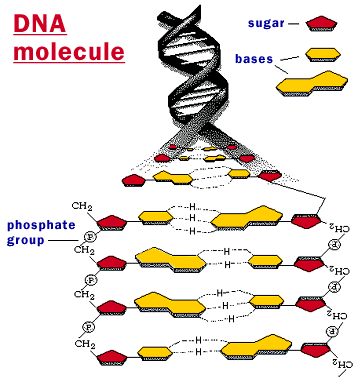3 Answers
Deoxyribonucleic acid (i/di??ksi?ra?b?.nju??kle?.?k ?æs?d/; DNA) is a nucleic acid containing the genetic instructions used in the development and functioning of all known living organisms (with the exception of RNA viruses). The DNA segments carrying this genetic information are called genes. Likewise, other DNA sequences have structural purposes, or are involved in regulating the use of this genetic information. Along with RNA and proteins, DNA is one of the three major macromolecules that are essential for all known forms of life.
DNA consists of two long polymers of simple units called nucleotides, with backbones made of sugars and phosphate groups joined by ester bonds. These two strands run in opposite directions to each other and are therefore anti-parallel. Attached to each sugar is one of four types of molecules called nucleobases (informally, bases). It is the sequence of these four nucleobases along the backbone that encodes information. This information is read using the genetic code, which specifies the sequence of the amino acids within proteins. The code is read by copying stretches of DNA into the related nucleic acid RNA in a process called transcription.
Within cells DNA is organized into long structures called chromosomes. During cell division these chromosomes are duplicated in the process of DNA replication, providing each cell its own complete set of chromosomes. Eukaryotic organisms (animals, plants, fungi, and protists) store most of their DNA inside the cell nucleus and some of their DNA in organelles, such as mitochondria or chloroplasts.[1] In contrast, prokaryotes (bacteria and archaea) store their DNA only in the cytoplasm. Within the chromosomes, chromatin proteins such as histones compact and organize DNA. These compact structures guide the interactions between DNA and other proteins, helping control which parts of the DNA are transcribed. wiki
| 12 years ago. Rating: 6 | |
DNA
1.
Genetics . deoxyribonucleic acid: an extremely long macromolecule that is the main component of chromosomes and is the material that transfers genetic characteristics in all life forms, constructed of two nucleotide strands coiled around each other in a ladderlike arrangement with the sidepieces composed of alternating phosphate and deoxyribose units and the rungs composed of the purine and pyrimidine bases adenine, guanine, cytosine, and thymine: the genetic information of DNA is encoded in the sequence of the bases and is transcribed as the strands unwind and replicate. Compare base pair, gene, genetic code, RNA.
2.
the set of nongenetic traits, qualities, or features that characterize a person or thing: Humility is just not in her DNA.
Origin:
1930–35; d ( eoxyribo ) n ( ucleic ) a ( cid )>>>>>
Dictionary.com Unabridged
Based on the Random House Dictionary, © Random House, Inc. 2012.

| 12 years ago. Rating: 4 | |

 KLINDO
KLINDO
 melandrupert
melandrupert
 lindilou
lindilou
 dad59
dad59




